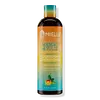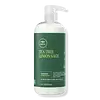What's inside
What's inside
 Key Ingredients
Key Ingredients

 Benefits
Benefits

 Concerns
Concerns

 Ingredients Side-by-side
Ingredients Side-by-side

Isopropyl Myristate
EmollientCocos Nucifera Oil
MaskingGlycerin
HumectantGlycine Soja Oil
EmollientCetyl Alcohol
EmollientBehentrimonium Methosulfate
Cetearyl Alcohol
EmollientPrunus Amygdalus Dulcis Oil
Skin ConditioningCetrimonium Chloride
AntimicrobialCitric Acid
BufferingPolyquaternium-37
Polyquaternium-10
Isostearyl Isostearate
EmollientArgania Spinosa Kernel Oil
EmollientMangifera Indica Seed Butter
Skin ConditioningPPG-3 Benzyl Ether Myristate
EmollientHelianthus Annuus Seed Oil
EmollientLavandula Angustifolia Oil
MaskingMelaleuca Alternifolia Leaf Oil
AntioxidantAlgae Extract
EmollientAloe Barbadensis Leaf Juice
Skin ConditioningPPG-14 Butyl Ether
Skin ConditioningOcimum Americanum Leaf Oil
MaskingPhenoxyethanol
PreservativeBenzoic Acid
MaskingPPG-10 Cetyl Ether
Skin ConditioningEthylhexylglycerin
Skin ConditioningGlycereth-2 Cocoate
EmulsifyingPropylene Glycol Dicaprylate/Dicaprate
EmollientPPG-1 Trideceth-6
Skin ConditioningParfum
MaskingIsopropyl Myristate, Cocos Nucifera Oil, Glycerin, Glycine Soja Oil, Cetyl Alcohol, Behentrimonium Methosulfate, Cetearyl Alcohol, Prunus Amygdalus Dulcis Oil, Cetrimonium Chloride, Citric Acid, Polyquaternium-37, Polyquaternium-10, Isostearyl Isostearate, Argania Spinosa Kernel Oil, Mangifera Indica Seed Butter, PPG-3 Benzyl Ether Myristate, Helianthus Annuus Seed Oil, Lavandula Angustifolia Oil, Melaleuca Alternifolia Leaf Oil, Algae Extract, Aloe Barbadensis Leaf Juice, PPG-14 Butyl Ether, Ocimum Americanum Leaf Oil, Phenoxyethanol, Benzoic Acid, PPG-10 Cetyl Ether, Ethylhexylglycerin, Glycereth-2 Cocoate, Propylene Glycol Dicaprylate/Dicaprate, PPG-1 Trideceth-6, Parfum
Water
Skin ConditioningCetearyl Alcohol
EmollientDimethicone
EmollientPanthenol
Skin ConditioningPanthenyl Ethyl Ether
Stearamidopropyl Dimethylamine
EmulsifyingMelaleuca Alternifolia Leaf Oil
AntioxidantHelianthus Annuus Seed Oil
EmollientTocopherol
AntioxidantAlcohol
AntimicrobialBehentrimonium Methosulfate
BHT
AntioxidantCitric Acid
BufferingDisodium EDTA
Disodium Phosphate
BufferingGlyceryl Stearate
EmollientHydroxyethylcellulose
Emulsion StabilisingOlealkonium Chloride
Oleyl Alcohol
EmollientPEG-2m
Emulsion StabilisingSodium Phosphate
BufferingPolyquaternium-47
Skin ConditioningPolysorbate 60
EmulsifyingSilica
AbrasiveTridecane
PerfumingUndecane
EmollientSodium Benzoate
MaskingMagnesium Chloride
Magnesium Nitrate
Methylchloroisothiazolinone
PreservativeMethylisothiazolinone
PreservativeParfum
MaskingBenzyl Benzoate
AntimicrobialCitral
PerfumingLimonene
PerfumingLinalool
PerfumingWater, Cetearyl Alcohol, Dimethicone, Panthenol, Panthenyl Ethyl Ether, Stearamidopropyl Dimethylamine, Melaleuca Alternifolia Leaf Oil, Helianthus Annuus Seed Oil, Tocopherol, Alcohol, Behentrimonium Methosulfate, BHT, Citric Acid, Disodium EDTA, Disodium Phosphate, Glyceryl Stearate, Hydroxyethylcellulose, Olealkonium Chloride, Oleyl Alcohol, PEG-2m, Sodium Phosphate, Polyquaternium-47, Polysorbate 60, Silica, Tridecane, Undecane, Sodium Benzoate, Magnesium Chloride, Magnesium Nitrate, Methylchloroisothiazolinone, Methylisothiazolinone, Parfum, Benzyl Benzoate, Citral, Limonene, Linalool
Ingredients Explained
These ingredients are found in both products.
Ingredients higher up in an ingredient list are typically present in a larger amount.
Behentrimonium Methosulfate is an ammonium salt. It is mainly used to prevent static in haircare products as a surfactant.
Surfactants have differing ends: one side is hydrophilic while the other end is hydrophobic.
Surfactants also help your cleansers remove pollutants more easily from the skin.
Learn more about Behentrimonium MethosulfateCetearyl alcohol is a mixture of two fatty alcohols: cetyl alcohol and stearyl alcohol. It is mainly used as an emulsifier. Emulsifiers help prevent the separation of oils and products. Due to its composition, it can also be used to thicken a product or help create foam.
Cetearyl alcohol is an emollient. Emollients help soothe and hydrate the skin by trapping moisture.
Studies show Cetearyl alcohol is non-toxic and non-irritating. The FDA allows products labeled "alcohol-free" to have fatty alcohols.
This ingredient is usually derived from plant oils such as palm, vegetable, or coconut oils. There is debate on whether this ingredient will cause acne.
Due to the fatty acid base, this ingredient may not be Malassezia folliculitis safe.
Learn more about Cetearyl AlcoholCitric Acid is an alpha hydroxy acid (AHA) naturally found in citrus fruits like oranges, lemons, and limes.
Like other AHAs, citric acid can exfoliate skin by breaking down the bonds that hold dead skin cells together. This helps reveal smoother and brighter skin underneath.
However, this exfoliating effect only happens at high concentrations (20%) which can be hard to find in cosmetic products.
Due to this, citric acid is usually included in small amounts as a pH adjuster. This helps keep products slightly more acidic and compatible with skin's natural pH.
In skincare formulas, citric acid can:
While it can provide some skin benefits, research shows lactic acid and glycolic acid are generally more effective and less irritating exfoliants.
Most citric acid used in skincare today is made by fermenting sugars (usually from molasses). This synthetic version is identical to the natural citrus form but easier to stabilize and use in formulations.
Read more about some other popular AHA's here:
Learn more about Citric AcidHelianthus Annuus Seed Oil is the oil derived from the seeds of a Sunflower. Sunflower seed oil is non-fragrant. It is an emollient, meaning it helps to soften the skin.
Sunflower seed oil contains many fatty acids. The fatty acids found in sunflower seeds include (from highest amount to least): linoleic acid, myristic acid, palmitic acid, stearic acid, arachidic acid, oleic acid, and linolenic acid.
These fatty acids help the skin create ceramides. Ceramides play a role in repairing the skin barrier.
Helianthus Annuus Seed Oil helps moisturize the skin. This in turn helps the skin look more rejuvenated and smoother.
Sunflowers are rich in vitamin E.
Historians believe Indigenous cultures of North America domesticated sunflowers before corn. Thus they relied on sunflower oil for a variety of uses. One such use is moisturizing skin and hair.
Sunflower seed oil may not be fungal acne safe. We recommend speaking with a professional if you have any concerns.
Learn more about Helianthus Annuus Seed OilThis tea tree oil comes from the leaves of the Tea Tree plant. Tea tree oil has antioxidant, anti-inflammatory, and antimicrobial properties.
According to the book Journal of Profiles of Drug Substances, tea tree helps in reducing acne-causing bacteria such as Propionibacterium acnes. This is due to the Terpinen components of tea tree oil.
Tea tree may cause sensitivity and irritation for some people. This oil naturally contains fragrance such as linalool and limonene.
However, research shows irritation usually occurs when using pure tea tree oil and not in cosmetic products.
Tea tree oil was found to help relieve the symptoms of psoriasis in one study.
Tea tree oil is toxic when ingested. Another study showed it to caused damage to the nervous system of dogs and cats when applied to their skin or given orally.
Learn more about Melaleuca Alternifolia Leaf OilParfum is a catch-all term for an ingredient or more that is used to give a scent to products.
Also called "fragrance", this ingredient can be a blend of hundreds of chemicals or plant oils. This means every product with "fragrance" or "parfum" in the ingredients list is a different mixture.
For instance, Habanolide is a proprietary trade name for a specific aroma chemical. When used as a fragrance ingredient in cosmetics, most aroma chemicals fall under the broad labeling category of “FRAGRANCE” or “PARFUM” according to EU and US regulations.
The term 'parfum' or 'fragrance' is not regulated in many countries. In many cases, it is up to the brand to define this term.
For instance, many brands choose to label themselves as "fragrance-free" because they are not using synthetic fragrances. However, their products may still contain ingredients such as essential oils that are considered a fragrance by INCI standards.
One example is Calendula flower extract. Calendula is an essential oil that still imparts a scent or 'fragrance'.
Depending on the blend, the ingredients in the mixture can cause allergies and sensitivities on the skin. Some ingredients that are known EU allergens include linalool and citronellol.
Parfum can also be used to mask or cover an unpleasant scent.
The bottom line is: not all fragrances/parfum/ingredients are created equally. If you are worried about fragrances, we recommend taking a closer look at an ingredient. And of course, we always recommend speaking with a professional.
Learn more about Parfum